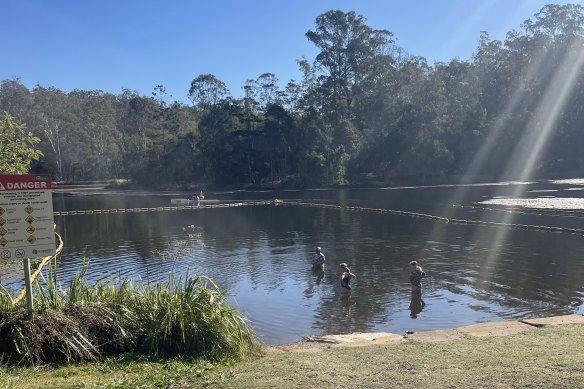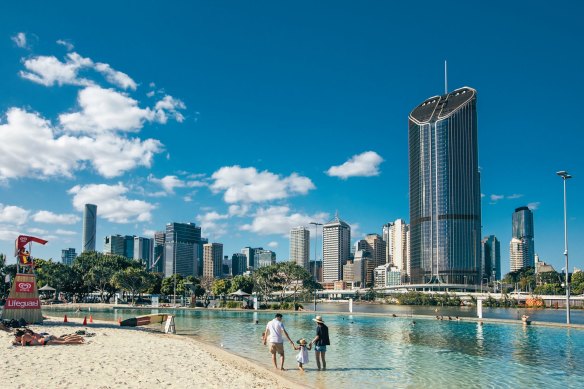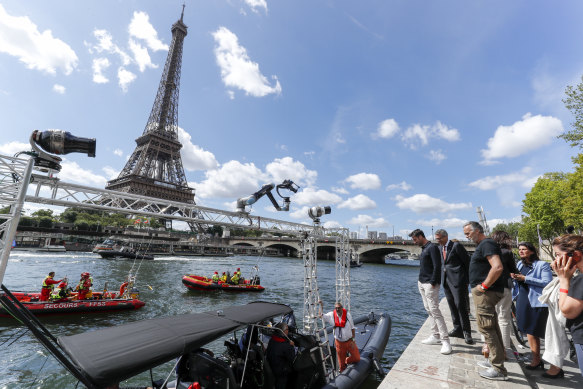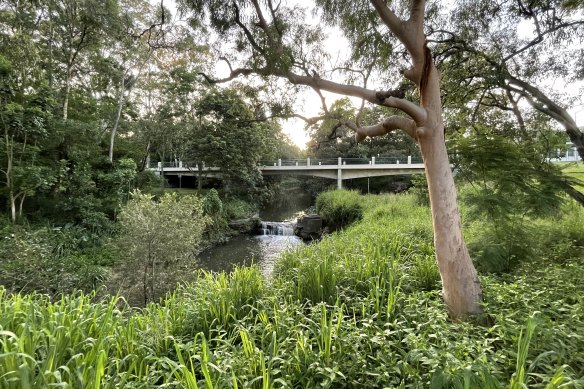- Perspective
- National
- Queensland
- City life
This was published 11 months ago
Would you swim in the Brisbane River?
When I first moved to Brisbane from the Northern Rivers, my biggest fear wasn’t that I wouldn’t like living in a city, it was that I would lose the one thing that had been maintaining my sanity for the past few years: places to swim.
That’s how I found myself diving into water with a faint muddy tinge 30 minutes from the CBD at Enoggera Reservoir last year.

Enoggera Reservoir is a much-loved swimming spot in west Brisbane, despite the murky water.Credit: Courtney Kruk
Of course, for something clearer, there’s always South Bank’s Streets Beach.
Ten years ago, with the arrogance of someone living by an actual beach, I might have mocked Brisbane’s artificial excuse for one. But now, living in the inner city, I see Streets Beach for what it is: a free, accessible public space that not many other cities have (and not a bad place to take a four-year-old on a hot summer’s day).
While Streets Beach was opened some years later, the entire South Bank precinct is a legacy of World Expo 88, an event that changed Brisbane physically and culturally.
Developers and politicians – including Greens lord mayoral candidate Jonathan Sriranganathan – are hoping the 2032 Olympics will have a similar impact.

It might be packed in summer, but Streets Beach has got to be one of Brisbane’s biggest brags. Credit: Tourism and Events Queensland
Last week, Sriranganathan floated an ambitious idea to make Brisbane River swimmable in time for the Games, suggesting a $6 million investment over four years to improve its water quality.
“If we can reduce the volume of sediment and silt that’s washing into the river, it will be a lot cleaner,” he told Nine News reporters, with the caveat that: “You’d also need enclosures to protect from bull sharks and stop people getting dragged away in the current.” (Maybe he’s read this Reddit thread, or Lola in the Mirror.)
Brisbane wouldn’t be the first Olympic city to clean up a natural asset. Paris has spent more than $2 billion revamping the Seine ahead of this year’s Olympic and Paralympic Games in the hope of using it for the opening ceremony parade (the first to be held outside a stadium) and swimming events.
Brisbane could do the same.
When Federal Sport Minister Anika Wells visited Paris last year, she told a function at the Australian embassy she was impressed by France’s plans for the opening ceremony parade.
A couple of weeks ago, Lord Mayor Adrian Schrinner dismissed calls to host the key Olympic ceremonies at Suncorp Stadium, saying he wanted them to be free events on the Brisbane River.
When Paris hosted its first Olympics in 1900, seven swimming events were held in the Seine, but swimming in the river was banned in 1923 due to high levels of pollution from stormwater, sewage and chemicals.
If Paris succeeds in making its river swimmable for athletes, it plans to open the Seine to the public next year, leaving behind a recreational legacy for generations.

Paris will be the first city to host the Olympic opening ceremony outside a stadium, with plans to host the athletes’ parade on the Seine. Credit: Catherine Steenkeste/Getty Images
It’s not just Paris though; the urban swimming movement is experiencing something of a renaissance in cities around the world. In Australia, sites along Sydney’s Parramatta River and Melbourne’s Yarra are being cleaned up for swimming, and in European cities such as Copenhagen, Munich, Zurich and Basel urban swimming has become a popular activity.
Beyond the physical and mental health benefits of outdoor swimming, there’s an element of reclaiming a lost asset. It encourages people to value clean waterways and understand the industrialisation, pollution and sewage that made swimming in them hazardous. And it can improve the quality of life for people living in urbanised areas with limited access to the natural environment.
There’s also the social and cultural value of dedicated spaces to gather and swim. Bodies of water are powerful tools for place-making (just look at Melbourne’s Fitzroy Pool or Sydney’s ocean baths), and they have a strong egalitarian aspect too.
“What form of leisure is more accessible and democratic than dipping into a shared stretch of beach or a suburban pool on a baking summer’s day?” author Benjamin Law writes in the foreword of Places We Swim.

Norman Creek at Arnwood Place in Annerley is one of three sites the Greens want to investigate for outdoor swimming. Credit: Courtney Kruk
I don’t necessarily agree with Sriranganathan’s ambition to make the Brisbane River swimmable (based on an estimated 3000 bull sharks alone), but I appreciate the sentiment. As a subtropical city with a strong outdoor culture, it makes sense that we should have more places to swim.
The Greens have also proposed five new swimming pools and $2 million to investigate three new outdoor swimming spots similar to Enoggera Reservoir. One of them is only a few kilometres from where I live.
I couldn’t sleep this morning because I have – would you believe it – swimmer’s ear. So at 5am, I walked to Norman Creek, one of the Greens’ suggested swimming sites, to scope it out for a future dip.
I like the idea of swimming there much more than the Brisbane River.
Get the inside word on the news, sport, food, people and places Brisbane is talking about. Sign up for our City Talk newsletter here.